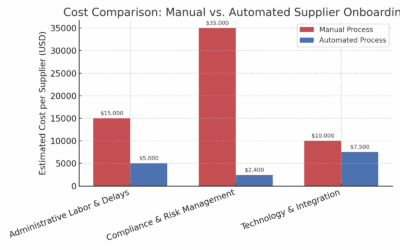
Supplier onboarding is supposed to be a quick, reliable way to bring new partners into your supply chain, but too often, it’s more of a headache than a helper. Onboarding processes are notoriously slow, inconsistent, and prone to risk. If you’re reading this, there’s a good chance your current process involves chasing down suppliers for the correct documentation, hitting line after line of wrong or incomplete data, or even trying to get suppliers to the right person in the first place.
All this inefficiency is costing your team time, creating compliance gaps, and frustrating your suppliers.
Sound familiar, or need some reinforcement that your onboarding “strategy” isn’t a strategy at all? Here are five signs that your supplier onboarding process may be holding you back, and what you can do to fix it.
Key Takeaways:
-
Manual processes waste time and increase errors – relying on email threads, PDFs, and spreadsheets slows onboarding and creates scalability issues.
-
Compliance gaps create risk – poor document tracking and late verification can lead to fines or failed audits.
-
Poor supplier experience damages relationships – unclear instructions or long delays frustrate suppliers and reduce engagement.
-
Incomplete data at onboarding causes downstream problems – missing tax forms or certifications create issues later in procurement, AP, and compliance.
-
Lack of visibility delays decisions – without real-time status tracking, teams are left guessing whether a supplier is ready to work.
1. Your team is stuck in inboxes and spreadsheets
Does bringing on a new supplier feel like a literal wild goose chase? If your onboarding process relies on email threads, random, scattered, and siloed forms, and manual data entry, you’re not alone.
These outdated tools not only eat up your team’s time but also create too many opportunities for important things to simply get missed and fall through the cracks.
What to fix: Look for ways to centralize and automate. A universal, company-wide platform can help your team spend less time managing files and more time managing relationships.
2. Compliance is always an afterthought
Collecting W-9s, verifying insurance, and checking certifications are all things that should happen automatically. Chances are, though, your team constantly scrambles to get this documentation in the first place.
If your team is running around in circles to gather this documentation or track it down after the fact, you’re putting your organization at risk.
What to fix: Build compliance into your onboarding process from day one. The right tools can automate collection, flag expired documents, and make future audits less painful.
3. Suppliers are silent throughout the process
When suppliers are unclear about expectations, they often either remain silent or push back. That can create delays, missed opportunities, and strained relationships before you’ve even issued the first PO.
If your onboarding process is confusing, it will set the wrong tone for your future relationship with suppliers. This could cause them to be less motivated to work with you.
What to fix: Make the experience straightforward. A transparent process with clear steps and consistent communication helps suppliers get started and stay engaged the whole way through.
4. You’re constantly chasing missing info

Nothing slows things down like incomplete submissions. If your team has to keep following up to get a tax ID, certificate, or contact name, your process isn’t doing enough heavy lifting. Missing information early on creates problems later for AP, sourcing, and risk management.
What to fix: Set up your intake forms to collect complete, validated data the first time. Use required fields and smart logic to guide suppliers through the process.
5. You never really know where things stand
If you’re constantly asking, “Is this supplier ready yet?” that’s a big red flag. Lack of visibility into onboarding status confuses internal teams and causes delays in decision-making. It also means your process is likely much slower than you realize.
What to fix: A status dashboard or onboarding tracker can help everyone, from AP to sourcing, stay on the same page and avoid unnecessary delays.
Moving Forward
A clunky onboarding process costs more than time. It weakens supplier relationships, exposes you to risk, and slows down critical workflows. If any of the signs above sound familiar, it’s time to take a closer look at how you bring new suppliers into your system.
Need help figuring out where to start? We can show you how other organizations have improved their process, and how you can, too. Schedule a call with our team of experts to discover how SupplierGateway can enhance your supplier onboarding process.












